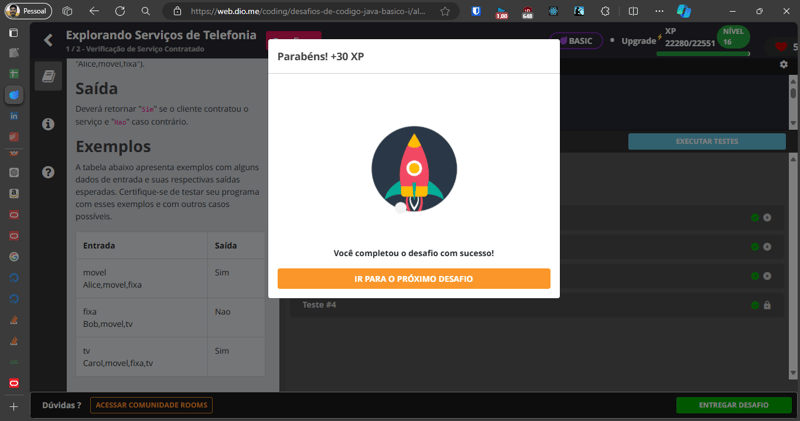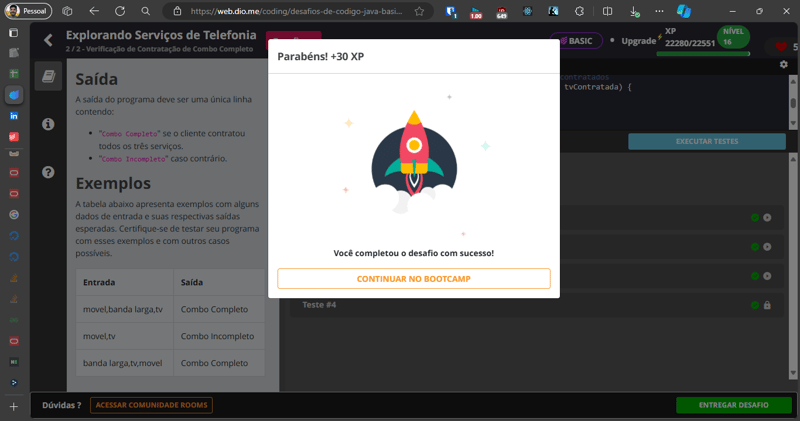
One of the things that I find really cool about DIO bootcamps is that during the trail there are some code exercises to be carried out, with an editor nearby and some conditions; a bit of a HackerRank vibe like that. It's really cool because it helps to consolidate the knowledge acquired during the theoretical parts and it's not a more complex approach like the project challenge: it's something more simplified, to test your logical reasoning and your knowledge of the language. Just like HackerRank, they give you some ready-made snippets and you develop your logic based on that.
This week was crazy, so the only thing I managed to do was solve the two challenges proposed in the module "Exploring Telephony Services". As the sponsor of this bootcamp is Claro, many of the themes will have a telecom flavor.
A telecommunications concessionaire offers four types of services: mobile telephony, fixed telephony, broadband and pay TV. To facilitate customer service, it is necessary to implement a program that checks whether a specific customer has contracted a certain service. For example, when a customer calls the call center and mentions a service, the attendant must be able to quickly check whether that service is contracted by the customer.
Two strings: One with the service that the application will check (for example, mobile, fixed, broadband, TV). The second must contain the customer's name and which products they have, separated by a comma (Alice, mobile, fixed)
If the customer contracted the service described in the first entry, the application must display Yes. Otherwise, it must display No.
| Entrada | Saída |
|---|---|
| movel Alice,movel,fixa |
Sim |
| fixa Bob,movel,tv |
Nao |
| tv Carol,movel,fixa,tv |
Sim |
import java.util.Scanner;
public class VerificacaoServico {
public static void main(String[] args) {
Scanner scanner = new Scanner(System.in);
// Entrada do serviço a ser verificado
String servico = scanner.nextLine().trim();
// Entrada do nome do cliente e os serviços contratados
String entradaCliente = scanner.nextLine().trim();
// Separando o nome do cliente e os serviços contratados
String[] partes = entradaCliente.split(",");
String nomeCliente = partes[0];
boolean contratado = false;
// TODO: Verifique se o serviço está na lista de serviços contratados
scanner.close();
}
}
This is a relatively simple challenge. The application receives a string delimited by commas that is transformed into an array and we need to find out if there is a string within it that matches another user input, which is the service we want to check if the client has. Easy, right?
For me, who has a history of JavaScript and C#, just use a checker method (like Array.includes() or List.Contains()). Right? Wrong.

In Java, there is no method like this in the Array class. This may be due to the implementation being much closer to what happens in low-level languages (such as C), which establishes that they must be simple and efficient data structures. Apparently this type of query is not part of the essential functions of this structure.
Discovering this information was a shock. What does Java expect me to do? That I write a loop for and check manually if each element matches the item I'm looking for? Brother, I work full time, I have a daughter under two years old and I'm still studying Java. I don't have time for that, man.
But I discovered that since Java 8 it is possible to convert the array into a list and this one has the .contains() method. So, to solve this problem, just convert the parts array into a list, and then check if the string passed in the service exists within this list.
If it exists, we print Yes and otherwise, we print No.
import java.util.Arrays;
import java.util.Scanner;
public class VerificacaoServico {
public static void main(String[] args) {
//...
// TODO: Verifique se o serviço está na lista de serviços contratados
contratado = Arrays.asList(partes).contains(servico);
System.out.println(contratado ? "Sim" : "Nao");
scanner.close();
}
}
With this the exercise is completed, but during the research I did I discovered that since Java 8 there is an abstraction that helps to work with collections of data in a simpler way and with a more functional approach, similar to what exists in JavaScript: streams.
Just like with lists, we can convert the vector into a stream and check if any of the elements present in it correspond to what was passed in the service:
import java.util.Arrays;
import java.util.Scanner;
public class VerificacaoServico {
public static void main(String[] args) {
Scanner scanner = new Scanner(System.in);
// Entrada do serviço a ser verificado
String servico = scanner.nextLine().trim();
// Entrada do nome do cliente e os serviços contratados
String entradaCliente = scanner.nextLine().trim();
// Separando o nome do cliente e os serviços contratados
String[] partes = entradaCliente.split(",");
String nomeCliente = partes[0];
boolean contratado = false;
contratado = Arrays.stream(partes).anyMatch(servico::equals);
System.out.println(contratado ? "Sim" : "Nao");
scanner.close();
}
}
We could have checked if p and servico not only have the same value but also point to the same address of memory (that is, if they are in fact the same object). Normally, when dealing with strings, this comparison will return false even if the value is equal -- that is, a false negative. Therefore, comparison using servico::equals is more appropriate, because it only compares the values between the two elements, more or less like the JavaScript equality comparator (==).
With this change, we can judge that the exercise is complete. What remains is to run the tests and see if they pass:

Too good.
This exercise gave me another reason to complain about Java, which is the lambda syntax. The use of the single arrow (->) instead of the double arrow (=>) bothers me a lot.
Implement a system that checks whether a customer of a telecommunications company has contracted a complete combo of services. A complete combo includes the three main services offered by the company: mobile telephony, broadband and pay TV. The system must read a list of services contracted by the customer and determine whether all necessary services are included. If all three services are present, the system should return "Complete Combo". If any of the services are missing, the system should return "Incomplete Combo".
A string containing the services contracted by the customer, separated by a comma. Possible values are mobile, broadband and TV.
A string containing Complete Combo if the client has all the services contracted, Incomplete Combo otherwise.
| Entrada | Saída |
|---|---|
| movel,banda larga,tv | Combo Completo |
| movel,tv | Combo Incompleto |
| banda larga,tv,movel | Combo Completo |
import java.util.Scanner;
public class VerificacaoComboCompleto {
// Função para verificar se o cliente contratou um combo completo
public static String verificarComboCompleto(String[] servicosContratados) {
// Variáveis booleanas para verificar a contratação de cada serviço
boolean movelContratado = false;
boolean bandaLargaContratada = false;
boolean tvContratada = false;
// TODO: Itere sobre os serviços contratados
for (String servico : servicosContratados) {
}
// TODO: Verifique se todos os serviços foram contratados
if () {
return "Combo Completo";
} else {
return "Combo Incompleto";
}
}
public static void main(String[] args) {
Scanner scanner = new Scanner(System.in);
// Solicitando ao usuário a lista de serviços contratados
String input = scanner.nextLine();
// Convertendo a entrada em uma lista de strings
String[] servicosContratados = input.split(",");
// Verificando se o cliente contratou um combo completo
String resultado = verificarComboCompleto(servicosContratados);
// Exibindo o resultado
System.out.println(resultado);
// Fechando o scanner
scanner.close();
}
}
De novo, esse é um desafio simples. Para chegar no resultado, apenas alguns passos precisam ser seguidos:
for (String servico : servicosContratados) {
if(servico.equals("movel")) movelContratado = true;
if(servico.equals("bandaLarga")) bandaLargaContratada = true;
if(servico.equals("tv")) tvContratada = true;
}
E preenchemos a condição do nosso if:
if (movelContratado && bandaLargaContratada && tvContratada) {
return "Combo Completo";
} else {
return "Combo Incompleto";
Assim como no primeiro, com essas adições o desafio pode ser considerado como completo, mas esses ifs, um seguido do outro me incomoda um pouco. Podemos alterar isso pra um switch pra ficar menos feio:
for (String servico : servicosContratados) {
switch (servico) {
case "movel":
movelContratado = true;
break;
case "banda larga":
bandaLargaContratada = true;
break;
case "tv":
tvContratada = true;
break;
default:
System.out.println("Serviço inválido.");
break;
}
}
Há quem diga que os ifs são de mais fácil leitura e que o ganho que a otimização traria para um switch tão pequeno como esse é desprezível. Outros diriam que eu tenho pouca consistência interna, reclamando de checar manualmente strings em um exercício e fazendo sem um pio em outro.
Pra essas pessoas eu digo:

O código final ficaria então:
import java.util.Scanner;
public class VerificacaoComboCompleto {
// Função para verificar se o cliente contratou um combo completo
public static String verificarComboCompleto(String[] servicosContratados) {
// Variáveis booleanas para verificar a contratação de cada serviço
boolean movelContratado = false;
boolean bandaLargaContratada = false;
boolean tvContratada = false;
for (String servico : servicosContratados) {
switch (servico) {
case "movel":
movelContratado = true;
break;
case "banda larga":
bandaLargaContratada = true;
break;
case "tv":
tvContratada = true;
break;
default:
System.out.println("Serviço inválido.");
break;
}
}
if (movelContratado && bandaLargaContratada && tvContratada) {
return "Combo Completo";
} else {
return "Combo Incompleto";
}
}
public static void main(String[] args) {
Scanner scanner = new Scanner(System.in);
// Solicitando ao usuário a lista de serviços contratados
String input = scanner.nextLine();
// Convertendo a entrada em uma lista de strings
String[] servicosContratados = input.split(",");
// Verificando se o cliente contratou um combo completo
String resultado = verificarComboCompleto(servicosContratados);
// Exibindo o resultado
System.out.println(resultado);
// Fechando o scanner
scanner.close();
}
}
Que, ao rodar a suite de testes, nos mostra que deu tudo certo:

O código desses (e dos demais) desafios está aqui.
Então é isso, pessoal. Até a próxima!
The above is the detailed content of Code Challenge - Exploring Telephony Services. For more information, please follow other related articles on the PHP Chinese website!
 How to download videos from Douyin
How to download videos from Douyin
 c language printf function usage
c language printf function usage
 What is the difference between ibatis and mybatis
What is the difference between ibatis and mybatis
 How to obtain the serial number of a physical hard disk under Windows
How to obtain the serial number of a physical hard disk under Windows
 getelementbyid
getelementbyid
 How to modify folder 777 permissions
How to modify folder 777 permissions
 java string to number
java string to number
 Can Weibo members view visitor records?
Can Weibo members view visitor records?




